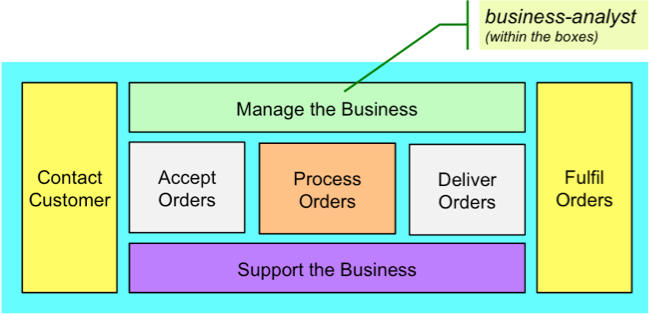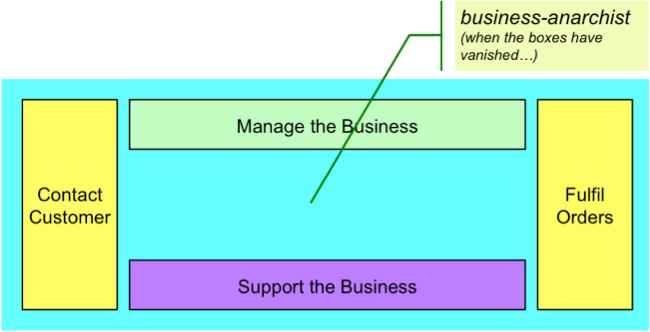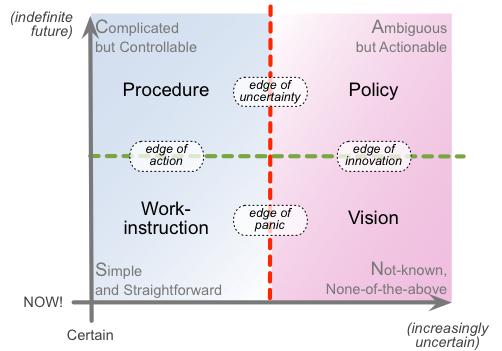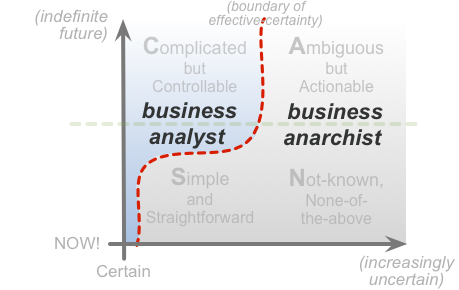The role and rise of the business-anarchist
You may have noticed some new role-titles turning up in the enterprise space. Chief Disruption Officer, for example. Or Chief Transformation Officer. A fair few variants on that theme.
But what you probably won’t see – not as yet, anyway – is the real role-title that unites them all: the role of the business-anarchist. The disciplines of working with uncertainty and apparent chaos in the business-domains and beyond, to enhance enterprise effectiveness overall.
Okay, people are often uncomfortable with the word ‘anarchist’ – it brings up all sorts of worrying allusions. But all that the word ‘anarchist’ literally means is ‘one who works without rules‘. And that capability is becoming more and more essential in business and elsewhere – especially in these turbulent times…
Consider, for example, the classic role of the business-analyst. They operate very much within a world of rules, ‘within the boxes’ – a world of analysis, always seeking to find ways to cajole the smallest scrap of extra efficiency from within some product or process:
But what happens if the existing business-model is disrupted? the supply-chain changes? when government or the market change the rules on us? Those finely-honed skills for working ‘within the boxes’ won’t help if the ‘boxes’ of the old business-model suddenly aren’t there any more…
At that point we need a very different type of skills, that can work directly with deep-uncertainty ‘beyond the rules’ in a disciplined way – the skills of the business-anarchist:
Think of it as an equivalent of the ‘white-hat hacker‘ – but at the same strategic level as a business-analyst, rather than down in the depths of security and systems. Or think of it in terms of ISO9000, perhaps:
- an operator or computer-system follows the rules of the work
- a process-designer or programmer writes the work-instructions that define the rules of the work
- a business-analyst writes the procedure that provides higher-level rules about how a work-instruction can be changed
- a business-anarchist identifies the context for new policy from which procedures may be derived
- the enterprise vision provides overall guidance for all
Which we could summarise on a SCAN frame (time/uncertainty mapping) as follows:
And which, in turn, suggests key parts of the skillset for any business-anarchist role – over on the matching right-hand side of the ‘boundary of effective-certainty’:
Or, to expand those keywords somewhat:
- recursion: identify, re-use and re-apply patterns that are self-similar at different scales and/or in different contexts
- reflexion: make use of the ways in which a whole can be seen within each individual element of that whole
- develop guidelines for use in exploration and experimentation
- reframe: use systematic methods such as TRIZ to provide alternate views onto the same nominal context
- rich-randomness: use ‘serendipity-machines‘ and similar sensing/sensemaking techniques to elicit new ideas from the Not-known
- develop principles to provide guidance within the Not-known in real-time action
To which we also need to add perhaps the most important attribute of all:
- deep commitment to professional ethics in all work and all action in a business-anarchist role
There’s one more twist to this that we ought to note: that things can seem a lot more certain in theory than they do in real-world practice. The result is that that dashed red line on the SCAN frame, representing ‘the boundary of effective-certainty’, takes on a distinct skew – which in turn means that the role of the business-anarchist may be much broader than we might at first expect:
Or, to put it another way, many of our front-line staff are likewise going to need strong elements of the business-anarchist’s skillset – particularly the ability to make sense and make decisions on the basis of principles alone, whenever Reality Department throws them over ‘the edge of panic’ into the realm of the Not-known, the None-of-the-above, the new. In contexts with high levels of uncertainty or uniqueness – such as in a hospital emergency-room, for example, or a police-beat, or just in an everyday customer-support call-centre – those skills make all the difference between a service that is effective, ‘on purpose’, and one that isn’t. In short, it matters.
So don’t be afraid of ‘the Big Bad Anarchist’ in business. It’s not something ‘bad’ at all, it’s something that we need – the set of skills that we need to make things work well in the midst of uncertainty.
Something to think about, perhaps?





Leave a Reply